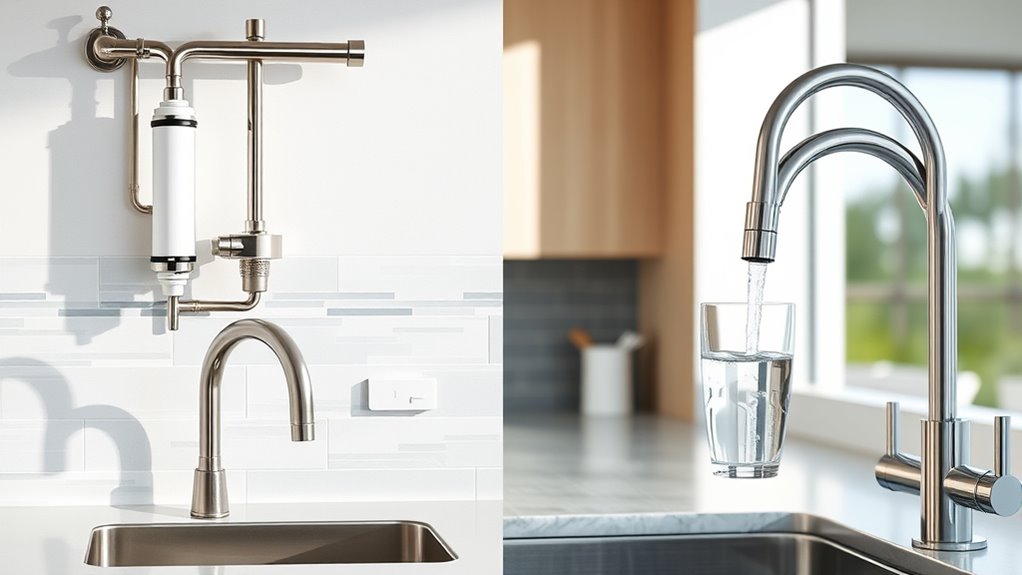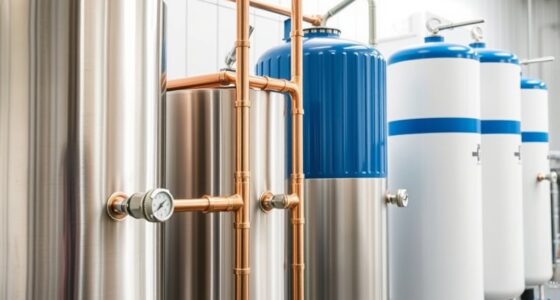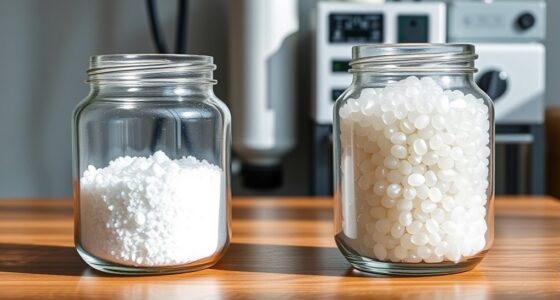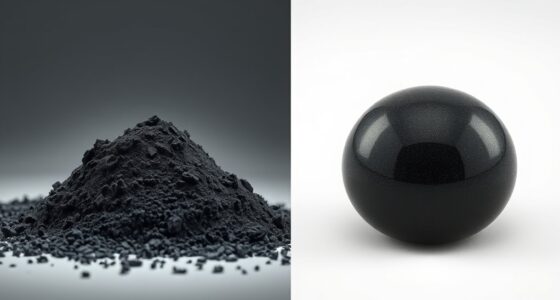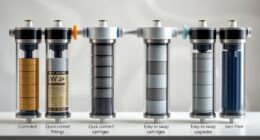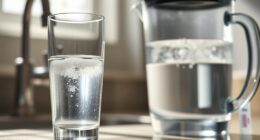Choosing between point-of-entry (POE) and point-of-use (POU) systems depends on whether you want whole-house protection or targeted purification at specific taps. POE filters all water for the entire home, ideal if you’re concerned about broad contaminants and appliances. POU systems are easier to install and better for addressing specific issues like lead or taste. Understanding your water needs and setup options will help you pick the right solution—so keep exploring your options.
Key Takeaways
- Choose POE for comprehensive, whole-house filtration covering all taps and appliances.
- Opt for POU for targeted treatment of specific water issues at individual faucets.
- Consider installation complexity and costs: POE is more involved; POU is typically DIY-friendly.
- Evaluate maintenance needs: POE usually requires less frequent upkeep; POU filters are easier to replace.
- Match your water quality concerns, budget, and maintenance capacity to select the most effective system.
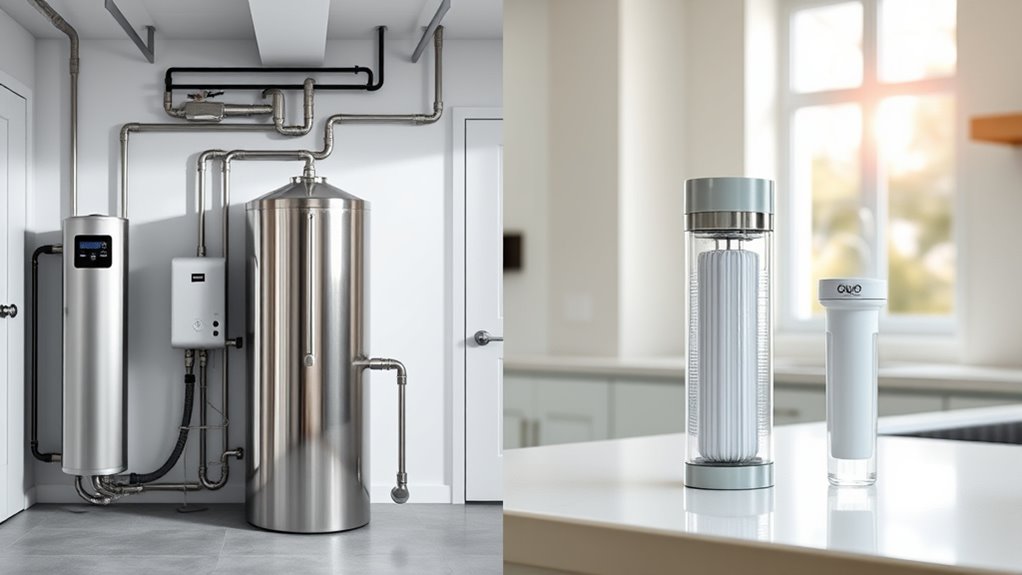
When choosing between point-of-entry (POE) and point-of-use (POU) water treatment systems, understanding your specific needs and water quality concerns is vital. Your decision hinges on factors like the level of filtration effectiveness you require, how much water you consume daily, and the potential installation challenges each system presents. POE systems treat water at the main supply line, providing whole-house filtration, while POU systems target individual taps, offering localized purification. Recognizing your priorities helps determine which approach aligns best with your lifestyle and water issues.
Filtration effectiveness varies markedly between these options. POE systems generally offer all-encompassing filtration, removing sediments, chlorine, heavy metals, and sometimes even bacteria across your entire household. This broad coverage ensures all water-using appliances and fixtures deliver cleaner water. Conversely, POU systems excel at addressing specific problems, like eliminating lead or improving taste at a single faucet. If your primary concern is complete protection, a POE system might be more suitable. But if you only need to address issues in one area—say, your kitchen sink—then a POU unit could be more economical and efficient.
Installation challenges also influence your choice. POE systems tend to be more complex to install because they require integration into your main water line, often needing professional plumbing work. This can be disruptive and might involve additional costs, especially if your plumbing setup is complicated or outdated. On the other hand, POU systems are typically easier to set up, often involving just attaching a filter or purifier directly to a faucet or installing under the sink. They’re usually DIY-friendly, saving you time and money, but you’ll need to ensure the unit fits your faucet or space constraints.
Another consideration is ongoing maintenance. POE systems generally require less frequent attention since they filter all water at once, but when maintenance is needed, it can be more involved due to their size and complexity. POU units might need more regular filter replacements, especially if used heavily, but these are usually straightforward to handle yourself. Think about your willingness and ability to perform maintenance, as well as how often you’ll need to replace filters or service the system.
Additionally, understanding the reliability and quality standards of the system you choose is essential to ensure safe and effective water treatment. Ultimately, your choice depends on your water quality issues, budget, and willingness to undertake installation and maintenance tasks. If you want a seamless, whole-house solution and don’t mind the installation process, a POE system might be right for you. If you prefer targeted treatment, easier setup, and lower upfront costs, then a POU system could serve your needs better. Carefully weigh these factors to ensure your water treatment choice effectively meets your needs.
Frequently Asked Questions
What Are the Long-Term Maintenance Costs for Each System?
You’ll find that point‑of‑entry systems generally have higher long-term maintenance costs due to their larger size and complexity, requiring regular inspections and filter replacements. In contrast, point‑of‑use systems usually have lower maintenance costs, with simpler maintenance schedules focused on filter changes. When doing a cost comparison, consider that ongoing upkeep for point‑of‑entry setups might be more expensive over time, but they offer broader water treatment coverage.
How Do These Systems Impact Water Pressure in a Building?
Point-of-entry systems can slightly reduce water pressure throughout your building because they regulate water flow at the main supply, ensuring consistent pressure. Point-of-use systems, on the other hand, focus on specific fixtures, so they generally don’t impact overall building pressure. Proper pressure regulation is essential; otherwise, you might experience low water flow or inconsistent pressure at your faucets, especially if your plumbing has limited capacity or old pipes.
Are There Specific Regulations Affecting System Installation?
Sure, because following rules is obviously optional, right? You must adhere to regulatory compliance and installation standards when installing these systems. Local codes often specify requirements for water quality, pressure, and safety measures. Skipping these rules risks fines or worse—water chaos. So, take the time to check with local authorities, confirm your installation standards are met, and avoid turning your plumbing project into a regulatory nightmare.
Can Existing Plumbing Be Adapted for Either System?
Yes, your existing plumbing can often be adapted for either system, but plumbing modifications may be necessary to guarantee system compatibility. You should inspect your current setup to identify any changes needed, such as new connections or rerouting pipes. Consulting a professional plumber helps determine the best approach, ensuring your system functions properly and meets local codes. Proper adaptation ensures seamless integration of point-of-entry or point-of-use systems into your plumbing.
How Do System Choices Influence Overall Water Quality?
Choosing a system impacts your water quality by affecting its purity and safety. Point‑of‑Entry systems often provide consistent, whole-house filtration, enhancing longevity and reducing contaminants, but may involve complex installation. Point‑of‑Use systems are simpler to install and focus on specific areas, but might not address all water quality issues throughout your home. Your choice influences maintenance, system lifespan, and the effectiveness of water purification.
Conclusion
Think of your water treatment options as a garden’s watering system. Point-of-entry is like a main water line watering the entire garden evenly, while point-of-use is like individual hoses for each plant, giving tailored care. Choosing between them depends on your needs—whether you want broad protection or targeted treatment. By selecting the right system, you’re nurturing a garden of pure, healthy water—each drop flowing smoothly, like a gentle stream nourishing your home.
